
1. properly evaluate new business opportunities; and
2. Typical credit process
2.1. Credit recovery
2.2. Business origination
2.2.1. Credit origination
2.2.2. Credit appraisal and review
2.2.3. Credit approval
2.3. Credit controls, review and analysis
2.3.1. Internal controls and audit
2.3.2. Independent credit review and audit
2.3.3. Portfolio review and trend analysis
2.3.4. Credit policy and process review
2.4. Credit administration and monitoring
2.4.1. Documentation and security
2.4.2. Disbursement and receipts
3. Availability of Competent Personnel These personnel should:
3.1. 1. have a complete understanding of the risks associated with the banking institution’s credit activities
3.2. 2. be able to understand the relevant factors and market conditions;
3.3. 3. report the risk profile of the banking institution’s credit portfolio to the appropriate lines of authority for information or consideration.
4. Maintenance of adequate policies and procedures
4.1. Policies and procedures that are properly developed and implemented will enable the banking institution to:
4.1.1. maintain sound credit-granting standards;
4.1.2. monitor and control credit risk;
4.1.3. identify and administer problem credits.
5. Availability of Effective Management Information System
5.1. The management information system should enable the banking institution to:
5.2. maintain a database for research and use of analytical techniques.
5.3. report exposures;
5.4. track quality and account performance; and
5.5. maintain limits.
6. Collateral policy
6.1. In assessing the acceptability of collateral, banking institutions should take into consideration the following: • the value of the collateral; • the ease of disposal of the collateral, namely its marketability (e.g. for securities, whether it is actively traded, over-the-counter, or closely held); and • the aggregate size of the particular collateral that the banking institution holds.
7. The primary components of a sound credit risk management process are: - a comprehensive risk measurement and evaluation approach; - a detailed structure of limits, guidelines and other parameters used to govern risk taking; - a sound, well-defined credit-granting criteria; - a strong management information system for controlling, monitoring and reporting risks; - an effective problem credit management process.
8. CREDIT-GRANTING CRITERIA
8.1. Banking institutions must operate under sound, well-defined credit-granting criteria. These should set out the qualifying criteria for: • the eligibility of credit and the amount qualified for; • the types of credit to be given; and • the terms and conditions to be applied on the credits granted.
9. Measurement methods
9.1. Monitoring and review
9.1.1. The process of evaluating and reviewing credit exposures regularly is fundamental to measuring and reporting exposures accurately.
9.2. Individual credits
9.2.1. An effective credit monitoring system should include measures to: • ensure that the banking institution understands the current financial condition of the borrower; • ensure all credits are in compliance with existing covenants; • monitor the usage of approved credit lines by borrowers; • ensure that the projected cash flow of major credits meet debt servicing requirements; • ensure that, where applicable, collateral provides adequate coverage; and • identify and classify potential problem credits on a timely basis.
9.3. Independent portfolio review
9.3.1. The review should cover the following: • monitor composition and concentration of risk; • review significant shifts in the portfolio composition; • migration of risk levels within the portfolio segment that could lead to increased risk levels or a review of credit-granting standards; • monitor changing economic environment, trends and events that could create new risk or increase the existing risk profile of the portfolio; • adequacy of provisioning levels of each portfolio; and • adequacy of earnings in relation to the risk in the portfolio.
9.4. Stress analysis
9.4.1. Three areas the banking institution should examine are: • economic or industry downturns; • market-risk events; and • liquidity conditions.
9.5. Limiting Risk
9.5.1. Scope of limits set boundaries for organizational risk-taking; be consistent with the institution’s overall risk measurement approach; be applied on a bank-wide basis where credit risks also arise in other activities of the banking institution; permit management to control exposures and to monitor actual risk taking against predetermined tolerances, as set by the Board or committee that oversees credit risk management; and ensure that exposures which exceed certain predetermined levels receive prompt management attention.
9.6. Individual Credit Limits
9.7. Portfolio Concentration
9.7.1. Concentrations occur when, among other things, a banking institution’s portfolio contains a high level of direct or indirect credits to: - a particular industry or sector - a geographic region - a type of credit facility or product group - a foreign country or a group of countries with strongly interrelated economies - a type of security - credits with same maturity
9.8. Breaches in limits
9.9. Reporting
9.9.1. The reporting system should be able to provide adequate information on: the composition of the portfolio; concentrations of credit risk; quality of various portfolios; and rehabilitated and “watch-list” accounts both on an entity and on a consolidated basis across various products (including off-balance sheet activities)
